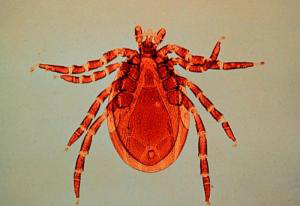March 24, 2008
Can Lyme Disease Be Prevented With A Single Injection?

By Michael D. Shaw
It was in 1994 that my friend and mentor, innovative publisher Richard Rimbach, Jr., succumbed to the late stages of Lyme disease. Dick Rimbach was the classic type A workaholic, but he did get some relaxation riding his tractor, working his acreage. Under those conditions, it was easy enough to get bitten by one of the ticks of the genus Ixodes (commonly the deer tick).
Although first described by German physician Alfred Buchwald in 1883, it would not be until 1975 that a series of cases emerging in southeastern Connecticut (including the towns of Lyme and Old Lyme), originally thought to be a form of juvenile rheumatoid arthritis, were found to be the same as the tick-borne infection better known in Europe. In 1982, the causative spirochete Borrelia burgdorferi—named after NIH researcher Willy Burgdorfer—was identified.
By all accounts, my friend was bitten some time in the late 1980s. Since the supposedly classic early symptom of a reddish “bull’s-eye” rash (erythema chronicum migrans) occurs in only 80% of patients, and the accompanying symptoms of fever, malaise, and musculoskeletal pain are so generic, given the time frame, he was diagnosed too late in the game.
As the disease progresses, further symptoms manifest, including loss of muscle tone on one or both sides of the face (Bell’s palsy), severe headaches and neck stiffness due to meningitis, shooting pains that may interfere with sleep, heart palpitations, dizziness due to changes in heartbeat, and pain that moves from joint to joint. With time, the arthritis can get much worse, and neurological problems such as loss of short term memory can occur. Sadly, in a small number of patients, even if treatment with antibiotics removes the infection, some symptoms can remain, perhaps as a result of an autoimmune response.
Even now, diagnosis is by no means straightforward. Unlike many bacterial diseases, serologic testing is not considered a gold standard here. Rather, Lyme disease is diagnosed based on symptoms, objective physical findings (such as the rash and arthritic conditions), along with a history of possible exposure to infected ticks.
As it happens, reliable polymerase chain reaction (PCR) tests for Lyme disease have been developed to detect the DNA of the Lyme disease spirochete, but these are beyond the scope of many conventional diagnostic labs.
Controversies have arisen around Lyme disease. The International Lyme and Associated Diseases Society advocates extended courses of antibiotics for chronic Lyme patients, while the Infectious Diseases Society of America does not recognize chronic infection and recommends no treatment for persistent symptoms. Likewise, it was long thought that controlling the deer population could mitigate spread of the disease, but recent research indicates that removing deer can actually increase tick density, as the arachnids simply choose rodents as their host, leading to the potential for tick-borne disease hot spots.
Into this fray come researchers at the CDC’s Division of Vector-Borne Infectious Diseases in Fort Collins, Colorado. In the April, 2008 issue of the Journal of Medical Microbiology, a team headed by Dr. Nordin Zeidner reports that a single injection of sustained-release antibiotics can prevent both Lyme disease and Anaplasmosis (also tick-borne) in mice.
Their work showed that a single dose oral dose of doxycycline is only 20-30% effective, compared to an injection of a new formulation of sustained-release doxycycline, that was 100% effective over a 20-day period.
Zeidner said, “We plan to test the doxycycline formulation to develop different release kinetics and delivery methods. For example, a slow release patch could be used in conjunction with current recommended protection against ticks, such as repellents and personal tick checks.”
Perhaps we are on our way toward what the paper calls “a viable prophylactic treatment option for multiple infectious agents in patients presenting with tick bites.” Good news for the nearly 20,000 Americans each year who get Lyme disease.

